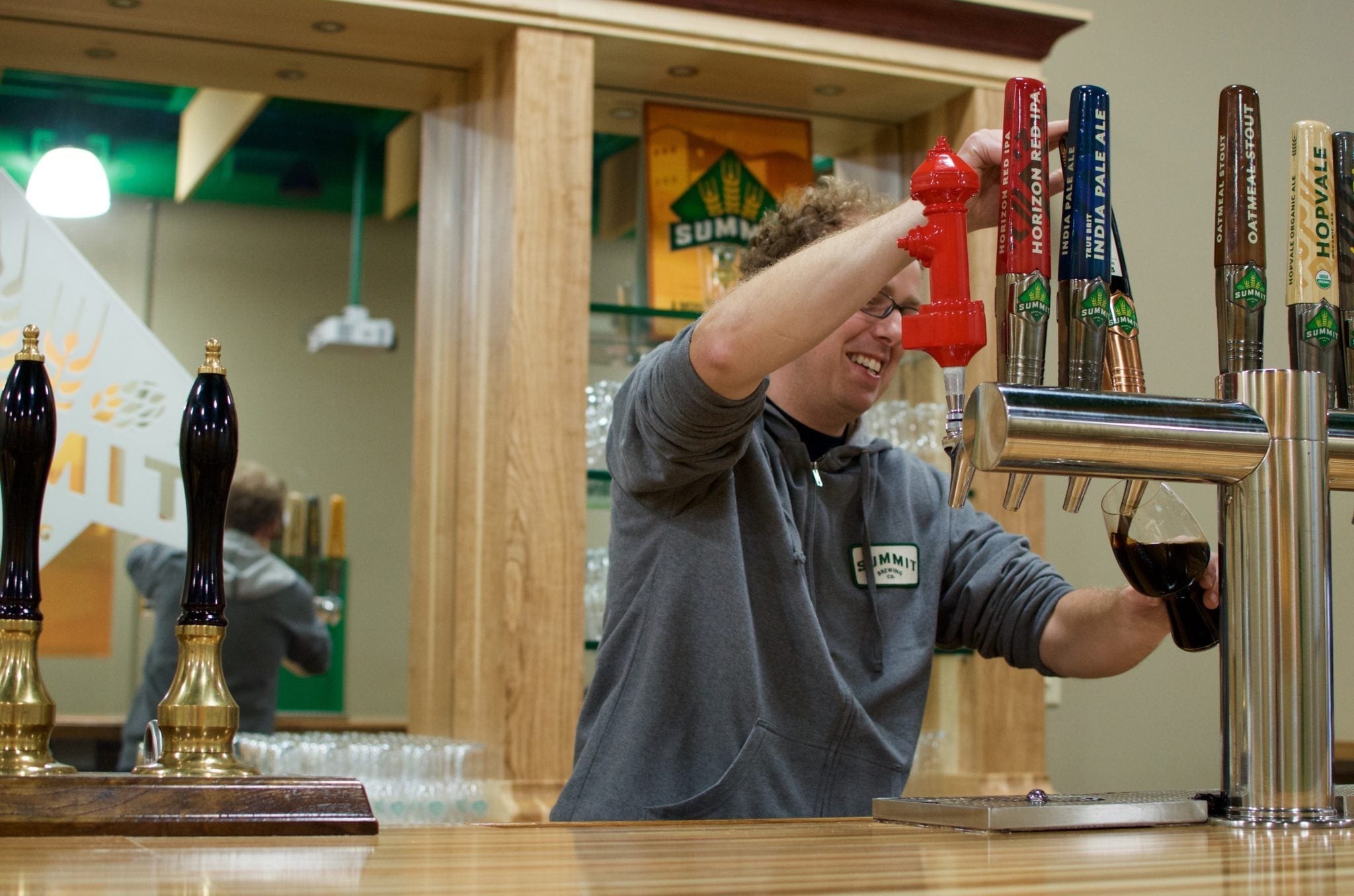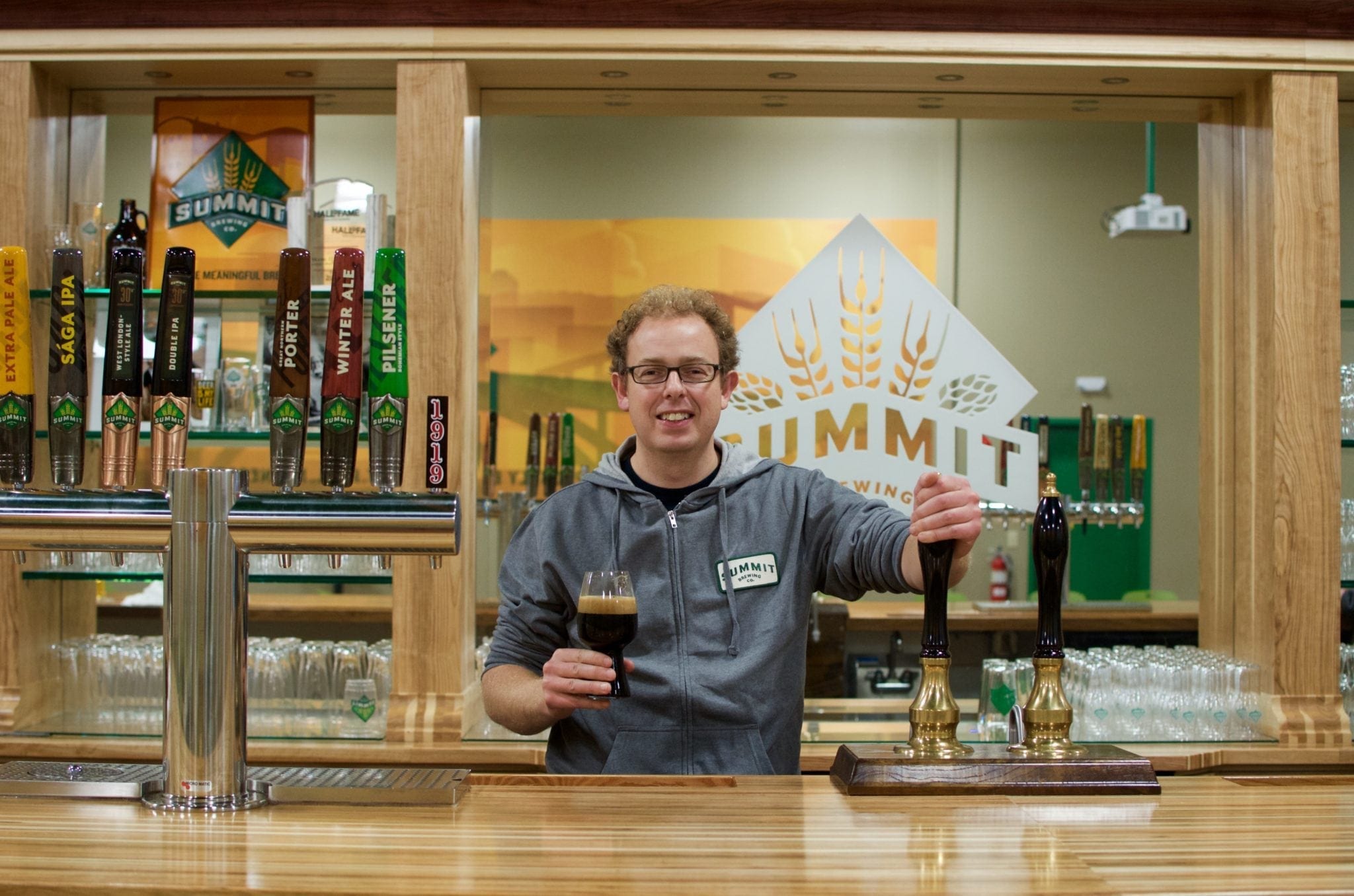Meet Damian McConn, Summit’s Head Brewer
Consistency. It’s what you have come to expect from Summit Brewing Company. But, is achieving a consistent brew as simple as it seems?
Definitely not.
Damian McConn, the Head Brewer of Summit (and better known as Damo), breaks it down for us.
What’s makes a brewer?
When Damo was recruited to Minnesota 17 years ago, he left a job at Guinness London. (You read that correctly…check out his beer creds here.) The brewer shifted from making millions of barrels of beer each year for Guinness to a mere hundreds for a small brewpub on this side of the pond.
Damo says he always recommends brewers work in brewhouses that range in size; at Guinness he gained access to top-of-the-line equipment and talented brewers who were recruited there. At the brewpub, McConn experienced the entirely hands-on, more involved brewing process that comes with smaller production volume.
Summit, Damo explains, lies somewhere in between, “Summit is a good size because it still has a family oriented approach.” However, the production volume also allows brewers to tackle complicated challenges, take risks, and become experts.
Why work at these different levels? Damo reasons that the experience and knowledge gained makes running a brewhouse far more productive. “There’s a lot more to running a brewery than brewing a great 5 gallon pale ale. It’s a question of whether you can run a business, manage staff, train servers, and interact with consumers and distributors.”
Why be consistent?
Consistency comes down to making–and keeping–a promise to your consumers. The idea is simply good business “It’s impossible to build inconsistent brands whether you’re a brewery, a distributor, or a retailer. If a consumer doesn’t know what they’re going to get week in week out, they’re going to get tired of it.”
“I should be able to purchase with confidence every time. One of the things I do as head brewer is assure and ensure a consistent product every time. You have to be able to make a consistent beer oftentimes with an inconsistent product.”
How do you achieve consistency?
 Every year, Summit must produce beer that tastes consistent with previous years, despite a vastly different product. Damo says, “One of the most stressful times of the year for a production brewery is when the new barley crop comes in and you’re blending that new barley in. Brewers will start blending it in slowly as part of a mix, so you have to rely on your relationship with your suppliers.”
Every year, Summit must produce beer that tastes consistent with previous years, despite a vastly different product. Damo says, “One of the most stressful times of the year for a production brewery is when the new barley crop comes in and you’re blending that new barley in. Brewers will start blending it in slowly as part of a mix, so you have to rely on your relationship with your suppliers.”
While consistency may depend on a strong line of communication with suppliers regarding product and timing, it also means selecting the right product for your beer. Each year, McConn and a team physically go out to the Yakima Valley in Washington to walk the hop yards to make selections with varied suppliers. He selects specific lots of the crop that he finds are most appropriate for that year; not every hop is right for every beer or brewery, and that varies even more greatly between seasons and lots.
What is your take on the Minnesota craft beer market?
“I came to Minnesota 17 years ago, and there were 8 operating breweries in the state. Now there are over 100 and a lot of those have arrived on the scene in the last couple years. A lot of those smaller breweries have relied on their taprooms to sustain them (as opposed to packaged product and on-premise account). The taproom bill has really helped them with that model.
We’ve started to catch up to states like Colorado, Oregon, and Vermont. The Midwest is usually behind the coasts in terms of trends. [The growth] has been really good in terms of media coverage and visibility for the profile of craft beer.
The danger is the consistency, education, and experience of people who have just arrived on the scene. The major goal [in craft beer] is respect for the person buying your beer. There’s a saying in Ireland that you never let the consumer pay for your learning curve. Brewers need to maintain patience and quality assurance. At the end of the day, it has to be about the consumer, and you have to remember that folks are putting down their hard earned cash on the counter or the bar and they should know what to expect every time.”
Creativity Amongst Consistency – Unchained
Summit releases three brews in the Unchained series annually. Each is designed and brewed by one brewer on the team, a process that rotates alphabetically. The beer is released in limited volume and availability, and not a single one has been brought back. McConn acts as a technical advisor and advocate for procuring raw materials, but otherwise, each release is entirely up to the brewer assigned to it.
team, a process that rotates alphabetically. The beer is released in limited volume and availability, and not a single one has been brought back. McConn acts as a technical advisor and advocate for procuring raw materials, but otherwise, each release is entirely up to the brewer assigned to it.
The first Unchained release was a traditional German Kolsch with German ingredients. McConn comments, “I still get people coming up to me asking me to bring back Unchained #1!”
“The Unchained series started almost 8 years ago. The goal was to showcase the creativity and the innovation in the brewing team. We have seven terrific brewers now, we had six back when we started the series. They see the project all the way through from raw materials to recipe procurement to samplings out in the trade. It allows the brewers to play around with ingredients, it provides something fairly unique and obscure for the beer lover out there, and it showcases our creativity. It’s a credit to the lads that they’re coming up with unique beers that we haven’t made here before at the brewery.”
Where is Summit going in the next 30 years?
After leading the Minnesota craft beer scene for 30 years, how will Summit move forward? McConn brings it back to his main goals, “As a brewer you’re always trying to drive quality forward and focus on consistency. We also want to give consumers something new to try from an established brewery and to highlight creativity.”
“What I’m really interested in is how the local craft beer scene matures and moves forward.” McConn predicts consumers will expect a high-quality beer on a consistent basis and mature in terms of their palate.
“When it comes to styles, I think we’re seeing a shift to a more sessionable beer. Big hoppy IPAs aren’t going anywhere anytime soon, but they’re starting to lose their luster in more mature markets.” Beers with lower alcohol that still have flavor and character are more approachable for the regular consumer.
“For a brewery that’s been around for thirty years there’s been a lot of change, transition fluidity. It’s been great to see it all move forward at such a fast pace. People are excited; there’s a lot of passion a lot of optimism.”
While we can’t give away all of McConn’s secrets, we can tell you that year 31 will bring plenty of great surprises (and beer) from Summit.


